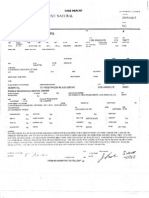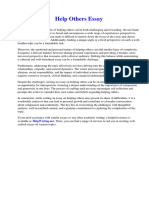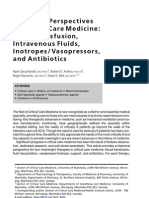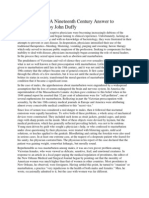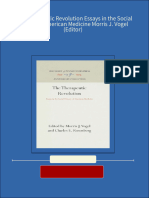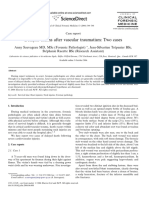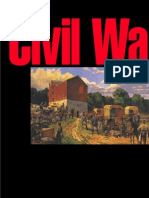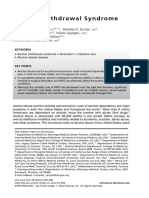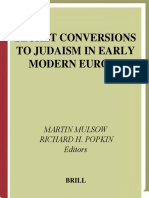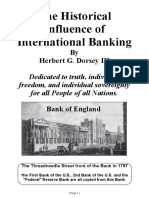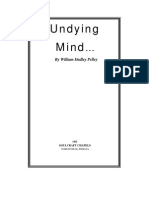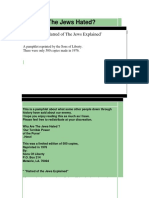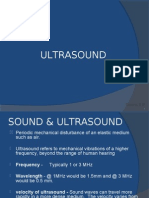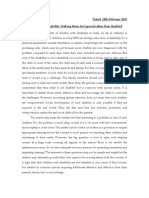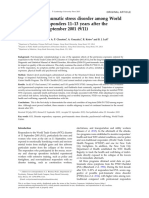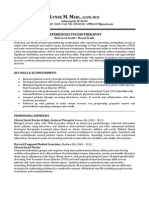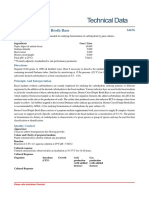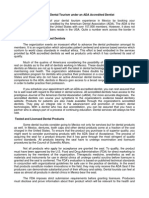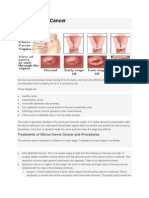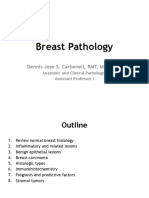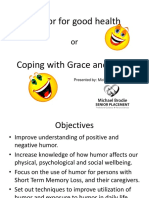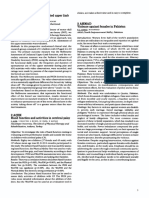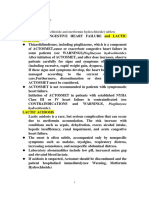Ochsner Journal (C. 12, No. 1, Spring 2012, Huey P. Long's Last Operation-When Medicine and Politics Don't Mix)
Ochsner Journal (C. 12, No. 1, Spring 2012, Huey P. Long's Last Operation-When Medicine and Politics Don't Mix)
Uploaded by
ayazan2006Copyright:
Available Formats
Ochsner Journal (C. 12, No. 1, Spring 2012, Huey P. Long's Last Operation-When Medicine and Politics Don't Mix)
Ochsner Journal (C. 12, No. 1, Spring 2012, Huey P. Long's Last Operation-When Medicine and Politics Don't Mix)
Uploaded by
ayazan2006Original Title
Copyright
Available Formats
Share this document
Did you find this document useful?
Is this content inappropriate?
Copyright:
Available Formats
Ochsner Journal (C. 12, No. 1, Spring 2012, Huey P. Long's Last Operation-When Medicine and Politics Don't Mix)
Ochsner Journal (C. 12, No. 1, Spring 2012, Huey P. Long's Last Operation-When Medicine and Politics Don't Mix)
Uploaded by
ayazan2006Copyright:
Available Formats
The Ochsner Journal 12:916, 2012
f Academic Division of Ochsner Clinic Foundation
Huey P. Longs Last Operation: When Medicine and Politics Dont Mix
Michael C. Trotter, MD, FACS
Delta Regional Cardiovascular and Thoracic Surgery, Greenville, MS
ABSTRACT
Ochsner has a rich historical heritage in the Gulf South, Louisiana,
and New Orleans. It is therefore not surprising that connections
exist between Ochsner and one of the most important events in
Louisiana history in the 20th century. This article examines the
medical care Huey P. Long received after a gunshot wound in
1935 and the circumstances that may have ultimately led to his
demise, as well as the important questions of whether the care he
received was consistent with standards of the time and whether
the best available surgical team participated in his care. Politics
and medicine were intertwined in this incident, and the Ochsner
connections are worth examination in this context.
these shape history and provide a thought-provoking
basis for discussions of alternate history.
Ochsner institutions have a rich historical heritage
in the City of New Orleans, the State of Louisiana, and
the entire Gulf South,4,5 so it is not surprising that ties
exist between the stories of Huey P. Long and
Ochsner. It is worthwhile and interesting to examine
these historical connections in the context of the
events of September 8-10, 1935.
Did Long receive the usual and customary
standard of care, or was the quality of his care
suboptimal? Did the quality of his care contribute to
his demise? Might he have received better care if not
for the victims political alienation of his detractors?
Were talented surgeons and expert medical care
available but relegated to the sidelines?
INTRODUCTION
One of the most important events to occur in
Louisiana history in the 20th century was the shooting
of US Senator Huey P. Long on September 8, 1935,
and his death 2 days later.1 The cause and effect of
this event have been, and continue to be, debated.2
Long was a prominent and controversial political
figure in Louisiana and the United States in the 1920s
and 1930s. He has been accurately described as a
polarizing figure. His fatal injury and the medical care
he received are a noteworthy example of politics and
medicine being intertwined and inseparable, with
untoward consequences. Not until 1979-1980 when
the medical care of the Shah of Iran and its political
ramifications played out on an international stage did
we see a similar medical controversy as detailed in
Morgensterns excellent article.3 Situations such as
Address correspondence to
Michael C. Trotter, MD, FACS
Delta Regional Cardiovascular and Thoracic Surgery
1705 Hospital St.
Greenville, MS 38703
Tel: (662) 347-9588
Fax: (662) 335-6705
Email: mdatrotter@gmail.com
THE INJURY
Senator Huey P. Long (D-LA), age 42, sustained a
gunshot wound to the right upper abdomen at close
range just before 9:30 pm on September 8, 1935.6
Whether the shooting was an assassination attempt
by Baton Rouge physician Carl A. Weiss or an
accident by one of Longs bodyguards remains
definitively unanswered to this day despite a range
of opinions. The injury itself is best described in New
Orleans surgeon Frank L. Lorias case report:6-9
The bullet which struck Senator Long entered just
below the border of the right ribs anteriorly,
somewhat lateral to the midclavicular line. The
missile perforated the victims body, making its
exit just below the ribs on the right side posteriorly
and to the inner side of the midscapular line, not
far from the midline of the back.
The penetrating injury has been described as being
caused by a .22 cal., a .32 cal., a .38 cal., or a .45 cal.
weapon, or by a combination of 2 of them.6-8
Immediately after receiving the injury, Long managed
to move 40 feet down the hall and then down 4 flights
(28 steps) of stairs. He met an associate and was
brought by private car to Our Lady of the Lake
Sanitarium, approximately one-quarter mile away.6,9,10
Keywords: History, Huey P. Long, Ochsner, politics
PREOPERATIVE CARE
The author has no financial or proprietary interest in the
subject matter of this article.
Volume 12, Number 1, Spring 2012
On arrival at approximately 9:30 pm, Long was
awake and alert but pale and sweaty.9 His jacket and
9
Longs Last Operation
shirt were cut off.9,10 Arthur Vidrine, MD, superintendent of Charity HospitalNew Orleans (CHNO) and a
Long political appointee, happened to be in Baton
Rouge on business related to appropriations for his
hospital.1,11 He was present at the hospital and took
charge as the admitting physician.1,6,9-11 On examination Long was fully conscious and very nervous.6,9,10 His pulse volume was weak, faint, and
rapid.6,10 Blood pressure (BP) was low.10 The entrance wound was located just below the border of
the right rib cage anteriorly, lateral to the midclavicular
line, and vertical with the nipple.7-10 The exit wound
was posterior below the ribs on the right side in the
midscapular line near the midline.7-10 Long was given
caffeine and 2 cc sodium benzoate by hypodermic
needle.6 William H. Cook, MD, Baton Rouge general
surgeon and former CHNO house surgeon, was called
and arrived at the hospital.1,6,9,10
Vidrine examined Longs wound, typed and crossmatched him for a blood transfusion,9 cleaned the
wound, and at 9:45 pm Long was taken to Room 314, a
private room reserved for Catholic bishops. Longs BP
and pulse were taken every 15 minutes, and the foot of
the bed was elevated.6,10 He was given morphine
sulfate, gr 1/6, by hypodermic needle for pain.6 Long
reportedly demonstrated profound shock and clinical evidence of internal hemorrhage.7,8 Long received
a transfusion of blood donated by Lieutenant Governor
Jimmy Noe.6,9,10 He was diaphoretic and nauseated
and asked for and received ice.6,9,10 Cecil Lorio, MD, a
Baton Rouge pediatrician, was present.1,6,10 Longs
systolic BP was reported to be approximately
90 mmHg, and his pulse was above 110 bpm.9 Long
was in a cold sweat and received external heat.6,9,10 At
this point, Vidrine advised Long that surgery was
needed; the patient agreed.6,9
The decision to operate was made by committee,
including Longs aides and assistants, a variety of
medical consultants, and interested parties. Vidrine
called for assistance from experienced surgeons
locally and regionally.6 Long himself requested renowned New Orleans surgeon and chairman of
surgery at the Louisiana State University (LSU) School
of Medicine Urban Maes, MD.9,11 Long also requested Russell Stone, MD, another prominent New
Orleans surgeon.9-11 Maes was delayed when his
car, driven by resident James D. Rives, MD, was
involved in a minor accident just outside of New
Orleans.6,9 Others from New Orleans and Shreveport
set out for Baton Rouge, including CHNO residents
and Longs personal physician and political appointee
as superintendent of Charity HospitalShreveport,
E. L. Sanderson, MD.9,10
The decision was made to proceed with the
available manpower because of Longs deteriorating
10
condition. Vidrine became chief surgeon by default.
Cook served as first assistant, and Lorio served as
scrub technician.6,9 Cook was Long neutral,1,9 while
Lorio was pro-Long.2,6,9 Anesthesia was problematic.
The anti-Long Henry McKowen, MD, was reached. He
had made an off-hand comment a few days earlier
If I ever give Huey an anesthetic, I will put him to
sleep for goodand agreed to participate only if
Lorio would watch his every move as a witness.6,9
Lorio agreed.6,9 No x-rays were taken,1 and urinary
catheterization was not performed, nor was a digital
rectal examination. At 11:00 pm, Longs systolic BP
was 104 mmHg, and his pulse was 114 bpm.10 Long
was taken to the operating room with a weak and
rapid pulse.6
THE OPERATION
As author Ed Reed notes, Longs surgery was
one of the most bizarre and unreal operating room
settings that one could possibly imagine. Spectators,
bodyguards, and medical professionals elbowed each
other for space in the operating room.10 Long
biographer T. Harry Williams called it one of the
most public operations in medical history,11 and
Cecil Lorio described it as a vaudeville show.9,10
Although Vidrine was the surgeon of record,
assisted by Cook and Lorio, Pavy reported that Cook
actually did most of the surgery.1 Many nonmedical
individuals involved in the consensus decision for
surgery were present in the operating room as
spectators.1,6,9,11 Some wore surgical gowns; others
remained in street clothes.9 The scene has been
described as chaotic and frenzied9 as well as
strange.6 Ether and N2O anesthesia were first administered at 10:51 pm, and antitetanus serum was given.
Surgery started at 11:22 pm.6,10 Vidrine stood on the
left (traditionally the first assistants position) and
Cook on the right (traditionally the surgeons position).6 An upper right rectus splitting (paramedian)
incision was made, incorporating the anterior bullet
wound. Abdominal exploration revealed very little
free intraperitoneal blood. The liver, gallbladder, and
stomach were not injured. The small bowel mesentery
had a silver-dollar-sized hematoma, and there was a
small in-and-out colon perforation at the hepatic
flexure with minimal spillage.6-9,11
Clarence Lorio, MD, brother of Cecil and Longs
personal physician in Baton Rouge as well as a close
friend, arrived after the surgery had started and
offered his assistance, taking Cooks place.1,9,10
The colon wounds were primarily sutured, and the
abdomen was closed in layers. Records showed that
anesthesia ended at 12:14 am and surgery at 12:25
am.6 Pulse readings during anesthesia were recorded
as between 104 bpm and 114 bpm.6,10 After surgery
The Ochsner Journal
Trotter, MC
Vidrine is reported to have said, It was nothing. It
was just a perforation of the intestines.10
POSTOPERATIVE CARE
Postoperatively, the patient did not do well. He
was taken to Room 325 (or 314; reports differ), and
the foot of the bed was elevated.6,10 He may have
been catheterized at this point with no hematuria
detected.10 Many people went freely in and out of his
room, and most were nonmedical personnel.6 Longs
vital signs continued to deteriorate, and he never
regained full consciousness.6,9,10
Maes and Rives arrived at approximately 1:00 am,
and Rives described the situation as nothing short of
chaotic.6 Stone arrived somewhat later.6 Stone and
Vidrine discussed the operation, and Vidrine stated
that the right kidney was injured and bleeding.6,10
Stone asked if Vidrine had seen the kidney, and
Vidrine replied that he had only felt it.6 Apparently an
argument ensued regarding the cursory nature of the
operation; Stone eventually returned to New Orleans
without examining Long,1,6,10 and he estimated
Longs chances of survival at 50:50.10
At 2:00 am, an optimistic update on Longs
condition was issued from the hospital. At 2:40 am,
systolic BP was 96 mmHg and pulse was 140 bpm.10
In a 5:15 am bulletin, Vidrine noted that considerable
hemorrhage from the mesentery and omentum had
been observed intraoperatively.1,10 At 6:00 am, BP
was 82/63 mmHg, and pulse was 154 bpm. A blood
count indicated the presence of infection and that
Long was losing blood.10 At 6:40 am, (9 hours
postinjury and 6 hours postoperative), Stone7-9 or
Rives6 suggested urinary catheterization.10 The catheterization detected significant hematuria.6-10 Stone
felt this confirmed the major renal injury, and he and
Maes feltand all senior physicians agreedthat
Long was too unstable to withstand reoperation.6,9
Years later, some junior physicians present that night
questioned this decision given the patients steadily
declining course.1,10 Throughout the morning, Long
received intravenous (IV) injections of glucose, sucrose, and saline solutions, as well as adrenalin and
morphine for pain.10
At 1:00 pm, Long received a second transfusion from
one of his bodyguards. His BP rose from 105/78 mmHg
to 115/80 mmHg, his pulse rose to 140 bpm, and his
temperature increased.10 An hour later, Long received
a rectal instillation of laudanum, aspirin, brandy, and
saline. Vital signs were recorded as a pulse of 148 bpm,
less labored respirations, less cyanosis, and temperature of 103uF 4/5 axillary. The patient was noted as
being quieter.6,10 However, his BP fell to nearly
undetectable levels several times and was recorded
in the early afternoon as 92/82 mmHg, at which time
Volume 12, Number 1, Spring 2012
Longs pulse was 170 bpm. Nevertheless, reports
about his condition were optimistic.10 At 3:00 pm, an
oxygen tent was started, and Long received more
adrenalin. At 6:30 pm, BP was 92/65 mmHg and pulse
rate was 160-170 bpm.10 At 7:00 pm, his condition was
reported as declining.9,10 E. L. Sanderson, who had
arrived from Shreveport, noted that Longs condition
was extremely critical and not responding to
treatment.9
At 8:15 pm, Longs pulse was thready, and he
received a third transfusion from CHNO resident
Willard Ellender, MD, brother of Long crony and
Speaker of the Louisiana House of Representatives
Allen J. Ellender, (D-Houma).9,10 Longs pulse initially
slowed and then climbed from 91 bpm to 118 bpm.9
His vital signs were recorded as BP of 114/84 mmHg
and a pulse rate of 170 bpm. He was still febrile.10 At
8:30 pm, Vidrine stated that Long was holding his
own, but by 10:30 pm there was little hope.9 Longs
pulse rate continued to be monitored. At 11:30 pm, he
was partly conscious and not expected to survive the
night. An IV of glucose in normal saline was started.9 At
midnight, he received a fourth transfusion; a fifth was
unsuccessfully attempted 2 hours later. Shortly after
midnight, Long became delirious and restless, with
shallow respirations; the oxygen tent was removed.
Vital signs were BP 100/79 mmHg, pulse 170 bpm, and
temperature of 104uF 4/5 axillary.10
At 1:00 am, Longs BP was 92/64 mmHg.10 The
attendance of Jorda Kahle, MD, chief of urology at
the LSU School of Medicine in New Orleans, had
been requested after the suspicion of a renal injury
had heightened, and at 1:30 am Kahle retrieved
gross blood from the right perirenal area via direct
aspiration.6,9,10 He felt this indicated massive retroperitoneal hemorrhage.6-9 At 2:00 am ephedrine was
obtained at an outside pharmacy,10 indicating the dire
circumstances and the need for hemodynamic support. By 3:00 am, Longs family had been summoned.9 The patient was described as practically
morbid with marked bronchorrhea.7,8 His IV was
stopped. Respiratory dysfunction progressed, and his
respirations became increasingly labored. Long died
at approximately 4:10 am on Tuesday, September 10,
1935, just over 30 hours and 30 minutes postinjury.
Although preparations had been made for an autopsy,
it was not performed per Mrs. Longs wishes.10
AFTERMATH
The multiple attempts to clarify the situation have
been hampered because no autopsy was performed.
Medical records are missing or unavailable, and
eyewitnesses and direct participants were unwilling
to speak. The stories that were recorded were often
inconsistent.
11
Longs Last Operation
Although Rives described the scene as nothing
short of chaotic,6,10 chaos is inherent in medical
emergencies involving prominent political figures. A
well-known example is the trauma care that President
John F. Kennedy received in 1963 at Parkland
Hospital in Dallas. Those physicians were some of
the best trauma surgeons available. The difference is
chaos with a purpose as opposed to chaos without
direction: The medical care President Ronald Reagan
received in 1981 after his assassination attempt is an
example of chaos with a purpose, well described in
Wilbers excellent book Rawhide Down.12
Nevertheless, in Longs case, no x-rays were
taken preoperatively,1 and the patient did not undergo
urinary catheterization until the postoperative period.10 Presumably Long died as a result of ongoing
retroperitoneal hemorrhage from a renal injury not
diagnosed preoperatively and not addressed intraoperatively.
Edgar Hull, MD, another of the CHNO residents
brought in to provide postoperative care for Long,
maintained until his death in 1984 that Kahle aspirated
no blood from the perirenal area, that the conduct of the
operation was without fault, and that Long died from
peritonitis.1,10 Although many have dismissed Hulls
theory of peritonitis, fecal spillage was documented,
and abdominal irrigation was not reported as having
been carried out. Furthermore, in this preantibiotic era,
many individuals were present in the operating room in
violation of standard aseptic procedure.13 Interestingly
Hull and alleged shooter Carl Weiss were medical
school classmates, roommates, and friends.1
Long had often achieved his goals through intimidation and alienation. He has been described as
dictator, demagogue, fascist, socialist, and power
addict. Long had particularly alienated the medical
community in Louisiana, especially in New Orleans.1,10
As a result, it appears that many of the medical
consultants that night were passive, indecisive, and
noncommittal and did not want to be involved. They
were more than willing to let Vidrine take all of the
responsibility. Vidrine seemed to realize the situation
he was in and likely would have welcomed the
emotional, clinical, and technical support of a strong
and experienced surgeon. When that help did not
materialize, Vidrine found himself essentially alone and
isolated in a sea of chaos. No one else was willing to
take the lead.1
Questions about the operation persisted. Many of
the onlookers in the operating room asked if a bullet
was found. At one point, a small dark object was
retrieved; it was determined to be fecal material.10
The official investigation concluded that the injury was
a through and through gunshot wound. A nurse on
the case did not recall a bullet being found.1,10
12
However, Cook was said to have reported that a
bullet was removed from the body the following day,
and Clarence Lorio reportedly stated that a small
caliber bullet had been removed during surgery.1,10
Clarence Lorio is also said to have removed a bullet
from Longs abdomen at the funeral parlor the next
day, while Reed wrote that Vidrine reportedly removed a flattened lead slug from the right adrenal
gland.1,10 Vidrine later stated that Long had two
bullets in him, one of which was a .38. Vidrine is
supposed to have kept that bullet, passing it on to
relatives for safekeeping.1,10 Whether or not a bullet
was found and recovered remains unanswered.10 By
todays standards of care, bullet retrieval is more of a
forensic issue than a clinical one. In this case, the
forensic value would be monumental.
Why didnt the surgical team explore the retroperitoneum? Even if Vidrine was inexperienced in this
scenario, Cook was not. Cooks apparent lack of
surgical leadership at the operating table is strange.
Were the others intimidated by Vidrines leadership?
Was Vidrine intimidated by the politicians and Long
allies and cronies who were present? Perhaps the
surgeons felt the retroperitoneal hematoma was
stable, nonexpanding, and having a tamponade
effect. Additionally, it has been postulated that Longs
transient hemodynamic improvement in the early
postoperative period caused further bleeding and
ongoing hemorrhage,10 analogous to an awake
hypotensive patient with a contained ruptured abdominal aortic aneurysm who quickly exsanguinates
once BP increases to a normotensive state.
In 1935, abdominal gunshot wounds were considered very serious, if not fatal, injuries. Surgical
intervention was used, sometimes successfully. Hematuria as a sign of genitourinary injury was also
known. The contribution of x-ray information in aiding
the surgeon had been described. The relationship of
shock and hemorrhage had been demonstrated and
described by Blalock in 1927.14 Thus, it is reasonable
to assume that the knowledge and technology to
successfully treat Longs injury were available.
Nevertheless, it has been said that Vidrine
botched the operation.2 Surgical lore relates how
a senior surgeon obtains excellent results from good
clinical judgment gained from experience obtained
from bad clinical judgment. Vidrine lacked appropriate
training in gunshot wounds to the abdomen and likely
had never had the bad clinical judgment that begets
experience leading to good clinical judgment. Yet
others present did posses this skill set. A perfect
storm of circumstances involving a particular patient,
politics, and strong emotions led to a constellation of
events in which medical care was impacted, ultimately influencing the patients outcome.
The Ochsner Journal
Trotter, MC
Figure 1. Alton Ochsner, circa 1935. (Image reproduced with
permission from the Rudolph Matas Library of the Health
Sciences, Tulane University.)
THE CONNECTIONS
Alton Ochsner, MD (1896-1981) (Figure 1). In
1935 Alton Ochsner was a leading academician in
surgery and chairman of surgery at Tulane.15 He had
experience in and published about abdominal surgery
and caring for surgical patients.16 He also had a
history of conflict with Long and Vidrine.1,11,13,15
As noted, Vidrine played a key role in the effort to
save Longs life in that he was the physician in charge.
His background6,9,10 is important to an understanding
of the events during those days. He graduated from
Tulane University School of Medicine in 1921 and had
been a Rhodes scholar.10,15 Following an internship at
CHNO,10 Vidrine worked as a general practitioner in the
small south Louisiana town of Ville Platte, where he
championed the Long cause.6,13,15 He held the position
of chief surgeon and administrator at the Eunice
Sanitarium until 1926. Long appointed him superintendent of CHNO in 1929. Vidrine was largely considered a
political physician and Long political ally.10
When the chair of Tulane Universitys Department
of Otolaryngology became vacant, Vidrine asked the
dean of the Tulane Medical School, C. C. Bass, for the
position. Bass pointed out that Vidrine had not
specialized in otolaryngology, and Vidrine replied that
Volume 12, Number 1, Spring 2012
he could read up on it.13,15 He was denied the
position. Vidrine also requested an appointment as
professor of surgery from Tulane Chairman of Surgery
Alton Ochsner. Ochsner felt the appointment would
be inappropriate because as superintendent of
CHNO, Vidrine was a political appointee. Ochsner
denied Vidrines request with a suggestion that
Vidrine revisit the issue once his tenure as superintendent was completed. Just as Vidrine was not
qualified for the otolaryngology position, he was also
not qualified for a professorship of surgery because
he had little training in surgery.13,15
Another episode is important in considering the
events of September 8-10, 1935. In spring 1930, Alton
Ochsner seriously considered moving from New
Orleans and Tulane. In a letter to colleague Allen
Whipple, MD, at Columbia University, Ochsner expressed his frustration at being unable to train
surgeons and build the Department of Surgery at
Tulane because of the universitys dependence on
CHNO, which was politically controlled and uncooperative with the medical school.11,15 A copy of the
letter was taken from his coat pocket, and in
September 1930, it surfaced at the Roosevelt Hotel
in New Orleans, where the CHNO Board was
meeting.1,15 Long used the letter to show Ochsners
lack of absolute loyalty.11,13,15,17 Long canceled
Ochsners position as chief visiting surgeon and
barred him from CHNO. The letter was either given
to Long by Vidrine, or Vidrine facilitated its receipt by
Long.10,15
Long then announced a new medical school, LSU,
and named Vidrine as dean when it opened in fall
1931. Vidrine recruited Urban Maes, MD, noted
surgeon on the Tulane faculty, as chairman of the
Department of Surgery at the new medical school.13
One of the conditions of Maess acceptance of the
position was to rectify the situation with Ochsner (who
was reinstated in September 1932).1,11,15,17
Ochsner stated it was a fortuitous thing, although
it seemed a horrible blow at the time.15 These events
have been nicely summarized by Frank A. Riddick,
MD, who describes how these activities may well
have ultimately led to the formation of the Ochsner
Clinic.18
Ochsner maintained that Longs fatal injury was
from his bodyguards.6 Years later Longs son, US
Senator Russell B. Long, told him, You know, if my
father had had you to take care of him, he would be
alive today. Ochsners thought was I didnt know
Russell realized this.15 Given the character of
Ochsner and the humanism and empathy for patients
he demonstrated,15,16 it is hard to even consider that
he would have denied his expertise despite his
differences with Long and his politics.
13
Longs Last Operation
Thomas Edward Weiss, MD (1916-2004) (Figure 2). Tom Ed Weiss had a long and distinguished
career in internal medicine and rheumatology at
Ochsner from 1947 until his retirement in 1984. He
served as head of the Section of Rheumatology until
1977. He published nearly 60 articles and exhibits
between 1941 and 1981. In 1974, he served on the
Executive Committee of the Ochsner Board of
Trustees along with physicians William Arrowsmith,
Paul T. DeCamp, Merrill O. Hines, John C. Weed, C.
Thorpe Ray, and William D. Davis, Jr.4 Following his
retirement, Weiss was instrumental in the organization
and development of the Fellows Alumni Association
(now the Ochsner Alumni Association). I knew him in
this capacity during my tenure as president of the
Ochsner Alumni Board, 1999-2002. We developed the
annual Outstanding Alumnus Award, he was the first
recipient, and the award was named in his honor. He
treated generations of New Orleanians and was held
in the highest esteem by his patients (Charles J.
LeDoux, MD, personal communication, August 29,
2010). He was kind, compassionate, and a true
gentleman.
The Weiss family has a long history in the medical
profession. Tom Ed was the brother of Carl A. Weiss,
MD, the individual accused of shooting Long, who
was immediately gunned down by Longs bodyguards. Their father was a noted Baton Rouge
physician. Tom Ed, an LSU college student at the
time of Longs fatal injury, was at the scene minutes
after the shooting and developed his version of the
events over the years while burdened by history and
the task of building a medical career for himself. He
maintained his brothers innocence and spoke openly
about it (Ranel Spence, MD, personal communication,
June 27, 2010).1,7,9 His beliefs were given voice in
1963, 1986, and 1999 in books by Zinman, Reed, and
Pavy, respectively.1,9,10 The family has continued this
effort.19
Rudolph Matas, MD (1860-1957) (Figure 3).
Rudolph Matas, renowned and revered New Orleans
surgeon, was succeeded by Alton Ochsner as
chairman of surgery at Tulane in 1927.15,17 Subsequently, the two men had a close relationship for
30 years until Matass death.20
After his retirement from Tulane, Matas maintained
a vibrant and undiminished private practice. In 1935,
he was an active 75 and had developed a consuming
hatred for Long; his feelings were not subtle.17 Matas
detested political interference in medical matters,
such as Longs establishment of the new LSU School
of Medicine that many considered to be done out of
spite toward Tulane.17 Alton Ochsners ban from
CHNO further cemented Matass distaste for Long.
Nevertheless, as with Ochsner, Matass humanism
14
and empathy almost certainly would not have denied
Long the medical expertise Matas would have
provided if asked.20,21
Matas was also connected with other individuals
involved in the saga. Urban Maes was a Matas
favorite disciple and maintained a close relationship
with his mentor, as did many of Matass other
trainees.4 When Maes accepted the position as chief
of surgery at LSU, his relationship with Matas was
permanently damaged because of the schools
connection to Long even though one of the conditions of Maes acceptance was that Ochsner be
reinstated.17
Carl Weiss was a protege of Matas from 19261928 when he was in postgraduate training at Touro
Infirmary in New Orleans. Matas supported Weisss
effort to obtain further postgraduate training at
American Hospital in Paris from 1929-1930.1,9,10,17
Matas was also a member of the committee that
selected Louisiana winners of French government
scholarships to study in Paris. In this capacity, he
voted to select Yvonne Pavy of Opelousas in 1931.
In Paris she and Carl met, fell in love, and later
married.17
Frank L. Loria, MD, was another Matas-trained
New Orleans surgeon. Loria, perhaps more than
anyone else, examined the medical aspects of the
case and published them for the medical literature.6-9
He was a well-known and experienced surgeon who
was educated in penetrating injuries of the abdomen.
He had published several times on the subject prior to
1935.22-24 He did significant research on the Long
case and personally interviewed the 3 physicians
(Vidrine, Cook, and Cecil Lorio) who performed Longs
final surgery. Loria maintained that Longs operation
was improperly performed and that his death was the
result of ongoing retroperitoneal hemorrhage from a
missed renal injury.1,10
CONCLUSION
Although the death of Huey P. Long will continue
to be the subject of research, debate, speculation,
and controversy, Long was clearly a victim of timid
medical care when he needed aggressive and
purposeful treatment. Alternate history is interesting
to contemplate in this case. The most obvious
speculation is what would have happened if Maes
and Rives had arrived in time to operate? What if
Rudolph Matas had been called for advice? What if
Alton Ochsner had been called and successfully
operated and took charge of Longs care? Was
Ochsner not considered for consultation because of
politics, or was it just an oversight because of the
chaos of the situation? Clearly Long would have
benefitted from the talents of a surgeon such as
The Ochsner Journal
Trotter, MC
Figure 2. Thomas Edward Weiss, circa 1950s [L] and 1990s [R]. (Photos courtesy of the Ochsner Medical Library and Archives.)
Ochsner. The attributes of a great surgeonmaturity
of judgment, dexterity of hand, and serenity in
crisis25appear to have been absent that night. What
if Tom Ed Weisss assertions that Carl Weiss was not
the assailant and that the fatal gunshot was from
someone other than his brother are correct? What if
the official findings confirmed this assertion in the
1930s? Politics in Louisiana may well have undergone
permanent changes, and the impact may have had
national ramifications.
Interestingly, these questions may never be
definitively answered. However, this consideration of
alternate history raises the question of whether the
care Long received may have led to his demise. It is
reasonable to conclude that Long likely died from
hypovolemic and/or septic shock due to penetrating
abdominal trauma resulting in renal injury superimposed with peritonitis secondary to bowel perforation
and aseptic surgical conditions. Expert surgical care
unhindered by political constraints may have provided
the best opportunity for a successful outcome.
Although medical standards of care were evolving in
1935, sufficient existing expertise appears to have
been reasonably available. However, this expertise
was not available to Huey Long on that fateful night.
REFERENCES
1.
2.
3.
4.
Figure 3. Rudolph Matas, circa 1932. (Image reproduced with
permission from the Rudolph Matas Library of the Health
Sciences, Tulane University.)
Volume 12, Number 1, Spring 2012
5.
Pavy DA. Accident and Deception. The Huey Long Shooting. New
Iberia, LA: Cajun Publishing; 1999:9, 28-29, 51-55, 57-58, 61, 81-83,
151-155, 157, 168.
White RD. Kingfish: The Reign of Huey P. Long. New York, NY:
Random House, 2006:265-267.
Morgenstern L. The Shahs spleen: its impact on history. J Am Coll
Surg. 2011 Feb;212(2):260-268. Epub 2010 Dec 30.
Caldwell GM. Early History of the Ochsner Medical Center.
Springfield, IL: Charles C. Thomas; 1965:13.
Wilds J. Ochsners: An Informal History of the Souths Largest
Private Medical Center. Baton Rouge, LA: Louisiana State
University Press; 1985:35, 204.
15
Longs Last Operation
6.
7.
8.
9.
10.
11.
12.
13.
14.
15.
Deutsch H. The Huey Long Murder Case. Garden City, NY:
Doubleday & Company, Inc.; 1963:19-20, 93, 98-99, 103-104,
108-124, 150.
Loria FL. Historical aspects of penetrating wounds of the abdomen.
Surg Gynecol Obstet. 1948 Dec;87(6):521-549.
Loria FL. Historical Aspects of Abdominal Injuries. Springfield, IL:
Charles C. Thomas; 1968:184-188.
Zinman D. The Day Huey Long Was Shot. New York, NY: Ivan
Obolensky, Inc.; 1963:60, 98, 127-129, 133, 140-146, 150-151,
166, 168, 170-171, 175-176, 270-274.
Reed E. Requiem for a Kingfish. Baton Rouge, LA: Award
Publications/Ed Reed Organization; 1986:3-5, 140-167, 171-173,
221-228.
Williams TH. Huey Long. New York, NY: Alfred A. Knopf;
1985:515-516, 873-876.
Wilber DQ. Rawhide Down. The Near Assassination of Ronald
Reagan. New York, NY: Henry Holt and Company; 2011.
Salvaggio JE. New Orleans Charity Hospital: A Story of Physicians,
Politics, and Poverty. Baton Rouge, LA: Louisiana State University
Press; 1992:104-119, 127-131.
Sabiston DC Jr. The fundamental contributions of Alfred Blalock to
the pathogenesis of shock. Arch Surg. 1995 Jul;130(7):736-737.
Wilds J, Harkey I. Alton Ochsner, Surgeon of the South. Baton
Rouge, LA: Louisiana State University Press; 1990:76, 78-83.
16. Trotter MC. Alton Ochsners card file: A profile of medical history.
Ochsner J. 2010 Fall;10(3):217-221.
17. Cohn I. Rudolph Matas: A Biography of One of the Great Pioneers in
Surgery. Garden City, NY: Doubleday & Company, Inc.; 1960:377,
385-389.
18. Riddick FA Jr. Ochsner in literaturenonfiction. Ochsner J. 2007
Fall;7(3):140-146.
19. Dr. Carl Weiss, Jr. The shooting of Huey Long. Foundation for
Historical Louisiana. August 28, 2010. http://www.c-spanvideo.
org/program/297015-3. Accessed 27 May 2010.
20. Ochsner A. Rudolph Matas: scientist, scholar, and humanist.
J Cardiovasc Surg. 1962 Jan;3(1):3-11.
21. Trotter MC. Rudolph Matas and the first endoaneurysmorrhaphy:
a fine account of this operation. J Vasc Surg. 2010
Jun;51(6):1569-1571. Epub 2010 Mar 27.
22. Loria F. Visceral injuries in gunshot wounds of the abdomen. New
Orleans Med Surg J. 1927 Nov;80(5):283-289.
23. Loria F. Prognostic factors in abdominal gunshot injuries. New
Orleans Med Surg J. 1930 Dec;83(6):393-400.
24. Loria FL. The influence of haemorrhage in abdominal gunshot
injuries. Ann Surg. 1932 Aug;96(2):169-178.
25. Wright CD. Historical perspectives of The American Association for
Thoracic Surgery: Richard H. Sweet (1901-1962). J Thorac
Cardiovasc Surg. 2011 Jul;142(1):18-19.
This article meets the Accreditation Council for Graduate Medical Education and the American Board of
Medical Specialties Maintenance of Certification competencies for Medical Knowledge.
16
The Ochsner Journal
You might also like
- A Field Guide To Joint Disease in Archaelogy - J. Rogers and T. Waldron OCR ReduitDocument66 pagesA Field Guide To Joint Disease in Archaelogy - J. Rogers and T. Waldron OCR ReduitCeilidh Lerwick86% (7)
- The ADA Practical Guide To Dental ImplantsDocument192 pagesThe ADA Practical Guide To Dental ImplantsSimona Bila100% (2)
- Blood Work - Holly TuckerDocument401 pagesBlood Work - Holly TuckerRed Rex 2015100% (2)
- The Analytic Attitude Roy SchafferDocument34 pagesThe Analytic Attitude Roy Schaffermarlop50% (4)
- PTSD - A Short History (PDFDrive)Document257 pagesPTSD - A Short History (PDFDrive)Parisa Fadayee100% (2)
- The Cancer Cure That Worked PDFDocument18 pagesThe Cancer Cure That Worked PDFcorbu_george75% (4)
- Case Presentation On Ectopic Pregnancy ... NewDocument13 pagesCase Presentation On Ectopic Pregnancy ... NewPabhat Kumar91% (33)
- Great Britain, The Jews and Palestine (Samuel Landman, 1936)Document20 pagesGreat Britain, The Jews and Palestine (Samuel Landman, 1936)ayazan2006No ratings yet
- List of Satanic HolidaysDocument3 pagesList of Satanic Holidaysayazan2006100% (7)
- List of Satanic HolidaysDocument3 pagesList of Satanic Holidaysayazan2006100% (7)
- Harry Hopkins Medical BioDocument10 pagesHarry Hopkins Medical BioSteven Lomazow M.D.No ratings yet
- Michael Jackson Autopsy ReportDocument51 pagesMichael Jackson Autopsy ReportKiKi M KiKi100% (3)
- Jewish Disaste-Six-Point Star (O. J. Graham, 2002)Document26 pagesJewish Disaste-Six-Point Star (O. J. Graham, 2002)Abdurrahman Yazan0% (1)
- Adams Silas Walter - The Legalized Crime of BankingDocument143 pagesAdams Silas Walter - The Legalized Crime of BankingHaruhi SuzumiyaNo ratings yet
- Help Others EssayDocument6 pagesHelp Others Essayimmkhuwhd100% (2)
- Download Complete Complete Feltmaking 10 Easy Techniques and 25 Great Projects 1st Edition Gillian Harris PDF for All ChaptersDocument55 pagesDownload Complete Complete Feltmaking 10 Easy Techniques and 25 Great Projects 1st Edition Gillian Harris PDF for All ChaptersdemmismootinNo ratings yet
- The Colony: The Harrowing True Story of the Exiles of MolokaiFrom EverandThe Colony: The Harrowing True Story of the Exiles of MolokaiRating: 4 out of 5 stars4/5 (17)
- Perspectivas UTIDocument20 pagesPerspectivas UTIthiappoloniNo ratings yet
- Doctor Olds of Twillingate: Portrait of an American Surgeon in NewfoundlandFrom EverandDoctor Olds of Twillingate: Portrait of an American Surgeon in NewfoundlandNo ratings yet
- Guide To Forensic MedicineDocument270 pagesGuide To Forensic Medicinekaastor70% (1)
- Clitoridectomy: A Nineteenth Century Answer To Masturbation by JohnDocument3 pagesClitoridectomy: A Nineteenth Century Answer To Masturbation by JohnthewomenofislamNo ratings yet
- Full The Therapeutic Revolution Essays in The Social History of American Medicine Morris J. Vogel (Editor) PDF All ChaptersDocument69 pagesFull The Therapeutic Revolution Essays in The Social History of American Medicine Morris J. Vogel (Editor) PDF All Chaptersheninsthaee100% (2)
- A History of Surgery at Cook County HospitalFrom EverandA History of Surgery at Cook County HospitalNo ratings yet
- Revolutionary Surgeons: Patriots and Loyalists on the Cutting EdgeFrom EverandRevolutionary Surgeons: Patriots and Loyalists on the Cutting EdgeNo ratings yet
- P-DOPE: Killed Philip Seymour Hoffman, River Phoenix, Raphael de Rothschild and Thousands MoreFrom EverandP-DOPE: Killed Philip Seymour Hoffman, River Phoenix, Raphael de Rothschild and Thousands MoreNo ratings yet
- Delyed Deaths After TraumatismDocument5 pagesDelyed Deaths After TraumatismIulia LupascuNo ratings yet
- Pickett FinalDocument5 pagesPickett Finalapi-239724669No ratings yet
- Report and Opinion in The Case of Li WangyangDocument28 pagesReport and Opinion in The Case of Li Wangyang8964June4No ratings yet
- Famous Persons With Gastrointestinal, Liver or Pancreatic CancerDocument4 pagesFamous Persons With Gastrointestinal, Liver or Pancreatic CancerjohnNo ratings yet
- Red Onion State Prison - VA - Rashid Johnson's ReportsDocument20 pagesRed Onion State Prison - VA - Rashid Johnson's ReportsHRCFedUpNo ratings yet
- Leslie J. Reagan, Nancy Tomes, Paula A. Treichler-Medicine's Moving Pictures - Medicine, Health, and Bodies in American Film and Television (Rochester Studies in Medical History) (2007)Document356 pagesLeslie J. Reagan, Nancy Tomes, Paula A. Treichler-Medicine's Moving Pictures - Medicine, Health, and Bodies in American Film and Television (Rochester Studies in Medical History) (2007)Sergio Peralta100% (1)
- Living Victims of StrangulationDocument6 pagesLiving Victims of Strangulationitaa19No ratings yet
- The Mortal Presidency: Illness and Anguish in the White HouseFrom EverandThe Mortal Presidency: Illness and Anguish in the White HouseRating: 4 out of 5 stars4/5 (5)
- Teaching Surgeons’ Hands to Heal: A Urological Surgical Chairman’S Chronicle: the History of the Department of Urologic Surgery, University of Minnesota 1969 – 1993From EverandTeaching Surgeons’ Hands to Heal: A Urological Surgical Chairman’S Chronicle: the History of the Department of Urologic Surgery, University of Minnesota 1969 – 1993No ratings yet
- What's in It For Me? Discover The Universal Empathy of HumanityDocument8 pagesWhat's in It For Me? Discover The Universal Empathy of Humanityarajah143No ratings yet
- Not Your Ordinary Doctor: A Cavalcade of Artistic Apothecaries, Footloose Physicians and Murdering MedicosFrom EverandNot Your Ordinary Doctor: A Cavalcade of Artistic Apothecaries, Footloose Physicians and Murdering MedicosRating: 4 out of 5 stars4/5 (2)
- Civil WaDocument8 pagesCivil WaMichael LesterNo ratings yet
- Belbis Jr. V People G.R. No. 181052 CDDocument2 pagesBelbis Jr. V People G.R. No. 181052 CDLester Fiel PanopioNo ratings yet
- Sex Change and The Popular Press: Historical Notes On Transsexuality in The United States, 1930-1955Document30 pagesSex Change and The Popular Press: Historical Notes On Transsexuality in The United States, 1930-1955crobelo7No ratings yet
- Sex Change and The Popular Press: Historical Notes On Transsexuality in The United States, 1930-1955Document30 pagesSex Change and The Popular Press: Historical Notes On Transsexuality in The United States, 1930-1955crobelo7No ratings yet
- John Wilkes Booth's AutopsyDocument6 pagesJohn Wilkes Booth's AutopsyRuth Nugent100% (1)
- A Scientific Revolution: Ten Men and Women Who Reinvented American MedicineFrom EverandA Scientific Revolution: Ten Men and Women Who Reinvented American MedicineNo ratings yet
- The Graft: How a Pioneering Operation Sparked the Modern Age of Organ TransplantsFrom EverandThe Graft: How a Pioneering Operation Sparked the Modern Age of Organ TransplantsRating: 5 out of 5 stars5/5 (1)
- (Routledge Library Editions. History of Medicine - 12.) Porter, Roy - Wear, Andrew - Problems and Methods in The History of Medicine-Routledge (2019)Document273 pages(Routledge Library Editions. History of Medicine - 12.) Porter, Roy - Wear, Andrew - Problems and Methods in The History of Medicine-Routledge (2019)Luiz Santos100% (1)
- Pioneers Who Transformed Coronary Disease: From Eisenhower’s Heart Attack to Clinton’s Coronary Surgery and StentsFrom EverandPioneers Who Transformed Coronary Disease: From Eisenhower’s Heart Attack to Clinton’s Coronary Surgery and StentsNo ratings yet
- Kissinger and Rockefeller The Origins of AIDS and EbolaDocument6 pagesKissinger and Rockefeller The Origins of AIDS and EbolaAziz Omar100% (2)
- Jain, A Disgrace PDFDocument21 pagesJain, A Disgrace PDFrachel.avivNo ratings yet
- Masters of Health: Racial Science and Slavery in U.S. Medical SchoolsFrom EverandMasters of Health: Racial Science and Slavery in U.S. Medical SchoolsNo ratings yet
- Hoover Digest, 2016, No. 2, SpringDocument184 pagesHoover Digest, 2016, No. 2, SpringHoover Institution67% (3)
- Medicine Q BankDocument5 pagesMedicine Q Banklilingzhang888No ratings yet
- Agents of Apocalypse: Epidemic Disease in the Colonial PhilippinesFrom EverandAgents of Apocalypse: Epidemic Disease in the Colonial PhilippinesRating: 5 out of 5 stars5/5 (2)
- ISSN: 2157-7145: OMICS Publishing GroupDocument8 pagesISSN: 2157-7145: OMICS Publishing GroupAyuPutriAnggraeniNo ratings yet
- Alcohol Withdrawal SyndromeDocument37 pagesAlcohol Withdrawal SyndromeSandra Diaz ArangoitiaNo ratings yet
- History of Medicine. The Scientific Revolution and MedicineDocument177 pagesHistory of Medicine. The Scientific Revolution and MedicineIgor Semenov100% (3)
- Anderon 1983 Fractures of The Odontoid of The AixDocument12 pagesAnderon 1983 Fractures of The Odontoid of The AixTrọng PhanNo ratings yet
- How Sir Winston Churchill Starved 4 Million Indians: BooksDocument4 pagesHow Sir Winston Churchill Starved 4 Million Indians: Booksayazan2006No ratings yet
- Secret Conversions To Judaism in Early Modern Europe (2004) PDFDocument247 pagesSecret Conversions To Judaism in Early Modern Europe (2004) PDFayazan2006100% (2)
- How Sir Winston Churchill Starved 4 Million Indians: BooksDocument4 pagesHow Sir Winston Churchill Starved 4 Million Indians: Booksayazan2006No ratings yet
- Historical Influence of International Banking (Herbert G. Dorsey III) PDFDocument24 pagesHistorical Influence of International Banking (Herbert G. Dorsey III) PDFayazan2006100% (2)
- Critical Research of New World Order Literature PDFDocument6 pagesCritical Research of New World Order Literature PDFayazan2006100% (2)
- Pelley William Dudley - Undying Mind PDFDocument153 pagesPelley William Dudley - Undying Mind PDFayazan2006100% (1)
- Zionist Terror Network (Meir Kahane and The JDLDocument16 pagesZionist Terror Network (Meir Kahane and The JDLayazan2006No ratings yet
- GM Coogan - Money Creators Who Creates Money Who Should Create It 1935Document176 pagesGM Coogan - Money Creators Who Creates Money Who Should Create It 1935mrpoisson100% (2)
- Crimes in The Jasenovac Camp, Zagreb 1946 (State Commission of Croatia, 2008)Document74 pagesCrimes in The Jasenovac Camp, Zagreb 1946 (State Commission of Croatia, 2008)ayazan2006No ratings yet
- Greatest Story Never Told-Winston Churchill and The Crash of 1929 (Pat Riott, 1994) - AlıntılarDocument30 pagesGreatest Story Never Told-Winston Churchill and The Crash of 1929 (Pat Riott, 1994) - Alıntılarayazan2006100% (2)
- Jews and Anti-Semitism in Scandinavia (Knut Eriksen, 2011) - ÖzetDocument14 pagesJews and Anti-Semitism in Scandinavia (Knut Eriksen, 2011) - Özetayazan2006No ratings yet
- World Food Shortage-A Communist-Zionist Plot (Borge Jensen, 1947)Document93 pagesWorld Food Shortage-A Communist-Zionist Plot (Borge Jensen, 1947)ayazan2006No ratings yet
- Nizer On What To Do With GermanyDocument2 pagesNizer On What To Do With Germanyayazan2006No ratings yet
- Why Are The Jews Hated (1976)Document12 pagesWhy Are The Jews Hated (1976)ayazan200667% (3)
- Modern Exodus of The Jews of Egypt (Racheline Barda)Document21 pagesModern Exodus of The Jews of Egypt (Racheline Barda)ayazan2006No ratings yet
- Askeri RütbelerDocument32 pagesAskeri Rütbelerayazan2006No ratings yet
- Fields Edward Reed - Jews Behind Race Mixing PDFDocument16 pagesFields Edward Reed - Jews Behind Race Mixing PDFayazan200660% (5)
- Terror On The Ruby Ridge (Len Martin, 1993)Document63 pagesTerror On The Ruby Ridge (Len Martin, 1993)ayazan2006No ratings yet
- Jewish Quarterly Review (C. 100, No. 4, Sonbahar 2010, Rusya Ve SSCB'de Yahudi Düşmanlığı)Document14 pagesJewish Quarterly Review (C. 100, No. 4, Sonbahar 2010, Rusya Ve SSCB'de Yahudi Düşmanlığı)ayazan2006No ratings yet
- Ultrasound Phonophoresis PhysiotherapyDocument45 pagesUltrasound Phonophoresis PhysiotherapygenalinangNo ratings yet
- Slow Sand Filtration For Community Water Supply in Developing Countries No-11 1978Document181 pagesSlow Sand Filtration For Community Water Supply in Developing Countries No-11 1978Muhammad UsmanNo ratings yet
- CWSNDocument3 pagesCWSNShankar PurbeyNo ratings yet
- Bromet 2015Document13 pagesBromet 2015Muhammad Amin MisbahNo ratings yet
- Adult Clinical Social Worker Psychotherapist in Indianapolis IN Resume Lynne MerlDocument3 pagesAdult Clinical Social Worker Psychotherapist in Indianapolis IN Resume Lynne MerlLynneMerlNo ratings yet
- Bromo Cresol Purple Broth Base: CompositionDocument2 pagesBromo Cresol Purple Broth Base: CompositionMitha AriantiNo ratings yet
- Experience Dental Tourism Under An ADA Accredited DentistDocument2 pagesExperience Dental Tourism Under An ADA Accredited DentistReuben FerrerNo ratings yet
- The Basics of Retinal OCT Oct-BDocument58 pagesThe Basics of Retinal OCT Oct-BJomarNo ratings yet
- Belzona 2211: Instructions For UseDocument2 pagesBelzona 2211: Instructions For UseEnrique MurgiaNo ratings yet
- Abdominal Compartment SyndromeDocument22 pagesAbdominal Compartment SyndromeHalbana Al MaududyNo ratings yet
- Cervix Cancer Treatment - Cervical Cancer Treatment in India: Omega Hospitals, HyderabadDocument3 pagesCervix Cancer Treatment - Cervical Cancer Treatment in India: Omega Hospitals, HyderabadRyan ThompsonNo ratings yet
- Nutrition AssessmentDocument11 pagesNutrition Assessmentnikhild77No ratings yet
- NOVADAQ Corporate Presentation May 2015 - 0Document27 pagesNOVADAQ Corporate Presentation May 2015 - 0medtechyNo ratings yet
- P2 Breast Pathology (Patho Surg) PDFDocument120 pagesP2 Breast Pathology (Patho Surg) PDFThakoon TtsNo ratings yet
- Acceptance - Mindfulness - and - Science - Hayes Steven PDFDocument6 pagesAcceptance - Mindfulness - and - Science - Hayes Steven PDFBarbara B. Guimaraes100% (1)
- Humor For Good Health: Presented By: Michael Brodie, MBA, NHADocument32 pagesHumor For Good Health: Presented By: Michael Brodie, MBA, NHAYuva Lakshmi Ramesh BabuNo ratings yet
- Maverick Mark Cunningham Interview 2-14-13Document24 pagesMaverick Mark Cunningham Interview 2-14-13lublinerNo ratings yet
- Borderline Personality DisorderDocument368 pagesBorderline Personality Disordercarlesavila224678% (9)
- 2-Venous ThromboembolismDocument49 pages2-Venous ThromboembolismEverythingNo ratings yet
- # Vestibular Rehabilitation Therapy On BalanceDocument17 pages# Vestibular Rehabilitation Therapy On BalancehanNo ratings yet
- Clean Water ActDocument17 pagesClean Water ActDaniel Naoe FestinNo ratings yet
- Complex Amalgam Restoration (Final)Document26 pagesComplex Amalgam Restoration (Final)Neil HerreraNo ratings yet
- Thesis Submission 2Document5 pagesThesis Submission 2Karan100% (3)
- 2005-Developmental Medicine & Child NeurologyDocument60 pages2005-Developmental Medicine & Child NeurologyMuhammad Rizki PernadiNo ratings yet
- Turner Syndrome: A Guide For FamiliesDocument32 pagesTurner Syndrome: A Guide For FamiliesAsena TuiketeiNo ratings yet
- Actosmet+e+pi 20120405Document44 pagesActosmet+e+pi 20120405Eva BanjarnahorNo ratings yet
- Dr. Samuel Christian Frederic HahnemannDocument3 pagesDr. Samuel Christian Frederic HahnemannVijay KumarNo ratings yet











